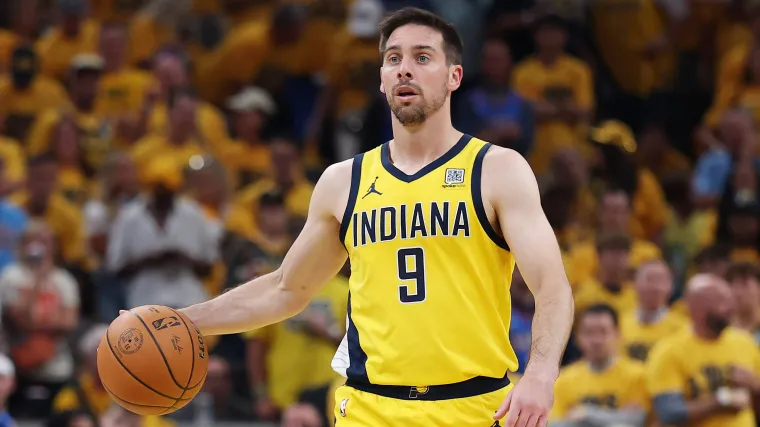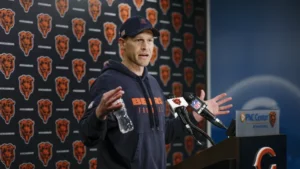If any NBA fans were still yet to catch on to the entertaining brilliance of one of the league’s most unique and physically diminutive players before this postseason, they’ve now seen the light.
Reserve point guard T.J. McConnell was a crucial force in the Indiana Pacers winning an Eastern Conference title and pushing the Oklahoma City Thunder to seven games in the NBA Finals this spring. And there’s not a high-impact bench player like anything him in the Association.
McConnell stands 6-0.5, 190 with a 6-2 wingspan and a throwback skill set – a lightning-quick probing point guard with an incredible motor who rarely makes mistakes and does nearly all his damage inside the arc, particularly in the mid-range. In 706 games and 14,921 minutes of action across 10 regular seasons, the 33 year-old has career averages of 13 points, 8.5 assists, and just 2.7 turnovers per 36 minutes, and he’s only made 172 threes against 2,235 two-point field goals.
This archetype of second string point guard and spot starter was quite common at the highest levels any time in basketball history through the early 2000’s, but once the three-point revolution hit, the NBA has become entirely void of T.J. McConnell’s – with the exception of McConnell himself.
In 22 postseason games leading up to Game 7 of the NBA Finals, McConnell averaged 9.2 points, 4.1 assists, 3.1 rebounds, and 0.9 steals per game in 17 minutes per game. Per 36 minutes, that’s 19.4 points, 8.7 assists, 6.6 rebounds, and 1.8 steals per game shooting 53.1% from the field. And in Game 7, he was at his best, particularly in the second half.
With Tyrese Haliburton gone to an Achilles injury in the first quarter, McConnell totaled 16 points, six rebounds, three assists, one steal, and one block on 8-13 shooting in just over 28 minutes of action. And the numbers don’t show just how much of a lifeline he was – nor the degree of difficulty on most of his buckets. There was a stretch of nearly 10 minutes spanning much of the third quarter and some of the fourth in which he was the only Pacer to score.
He finished the Finals averaging 12 points, 4.3 assists, 3.6 rebounds, and 2.1 steals in 20.3 minutes per game on 55.2% shooting, and might’ve garnered some Finals MVP consideration if Indiana had pulled out Game 7 without Haliburton. McConnell also holds the record for most steals in a half in NBA history, with nine coming in the first half against the Cleveland Cavaliers during a regular season game in 2021. All of this coming from a 6-0.5 player who went undrafted 10 years ago.
Despite the success he found in two years at Arizona State and a decade and counting at the NBA level, it’s probably not surprising to most that McConnell was far from a national recruit coming out of high school even though he was dominant.
McConnell played at Chartiers Valley High School in Pennsylvania for his father Tim McConnell and graduated in 2010 as the Pittsburgh Gazette male athlete of the year across all sports. McConnell averaged 34.2 points, 9.1 assists, and 8.2 rebounds per game as a senior to lead Chartiers Valley to a 29-2 record and state finals appearance – statistical dominance that’s rare even at the high school level.
And for all that, McConnell went unranked in 247Sports’ own rankings and earned a 3-star grade and No. 349 ranking in 247Sports’ Composite Rankings for the Class of 2010. Duquesne was the only Division I to offer him. Clearly he made the most of it, shining for two seasons at Duquesne before spending two at Arizona and becoming an NBA prospect.
It would be easy to say that scouts understandably missed on McConnell because of his lack of a three-ball, except for one key distinction – he was in high school 15 to 19 years ago. In 2006-2010, inside-the-arc scorers simply weren’t discriminated against yet at every level of scouting because the three-point revolution was yet to get into full swing. The NBA still had no shortage of fundamentally sound floor generals who had everything but range. The college coaches and scouts who whiffed on McConnell at Chartiers Valley simply underrated the guy.
And 15 years later, now that the meta of basketball has gone in the polar opposite direction of old school point guards like McConnell, he still manages to be a force on basketball’s biggest professional stage. It’s probably no coincidence that he’d already been an underdog since long before NBA circles had any clue who he was.
RELATED:






